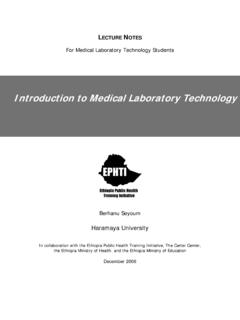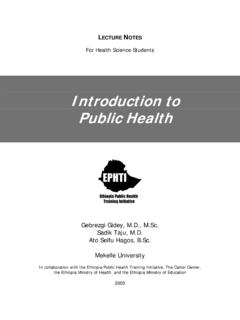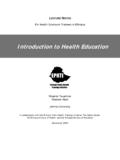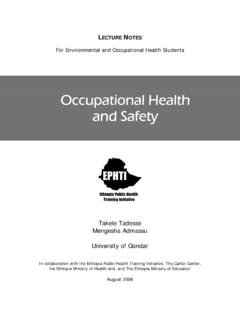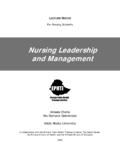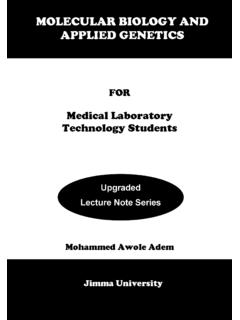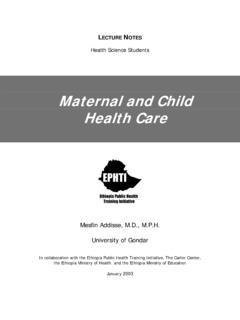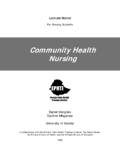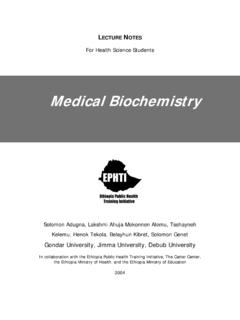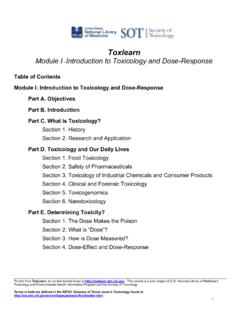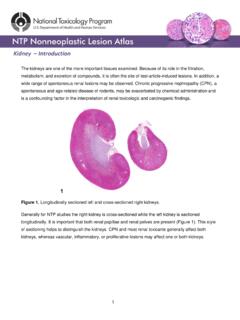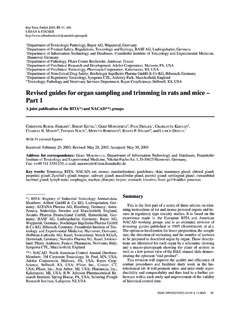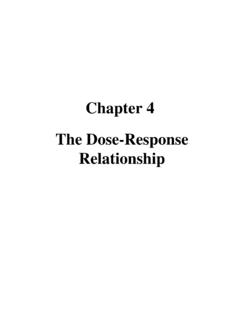Transcription of For Health Science Students - Carter Center
1 LECTURE NOTES For Health Science Students Pharmacology Teferra Abula, Srinivasa , Amare Mengistu, Solomomon Worku, Eshetu Legesse, Musie Aberra, Dawit University of Gondar In collaboration with the Ethiopia Public Health Training Initiative, The Carter Center , the Ethiopia Ministry of Health , and the Ethiopia Ministry of Education 2004 Funded under USAID Cooperative Agreement No. 663-A-00-00-0358-00. Produced in collaboration with the Ethiopia Public Health Training Initiative, The Carter Center , the Ethiopia Ministry of Health , and the Ethiopia Ministry of Education. Important Guidelines for Printing and Photocopying Limited permission is granted free of charge to print or photocopy all pages of this publication for educational, not-for-profit use by Health care workers, Students or faculty. All copies must retain all author credits and copyright notices included in the original document. Under no circumstances is it permissible to sell or distribute on a commercial basis, or to claim authorship of, copies of material reproduced from this publication.
2 2004 by Teferra Abula, Srinivasa , Amare Mengistu, Solomomon Worku, Eshetu Legesse, Musie Aberra, Dawit All rights reserved. Except as expressly provided above, no part of this publication may be reproduced or transmitted in any form or by any means, electronic or mechanical, including photocopying, recording, or by any information storage and retrieval system, without written permission of the author or authors. This material is intended for educational use only by practicing Health care workers or Students and faculty in a Health care field. iACKNOWLEDGMENT The authors would like to thank the Carter Center for the initiation and financial support of the preparation of this material. Ato Getu Degu s role in coordinating this work is greatly acknowledged. Finally, we thank the department heads and the faculty heads of the Health institutions for their cooperation to participate in the preparation of the lecture note. iiINTRODUCTION Pharmacology is a medical Science that forms a backbone of the medical profession as drugs form the corner stone of therapy in human diseases.
3 Therefore, it is of utmost importance to describe the pharmacological basis of therapeutics in order to maximize the benefits and minimize the risks of drugs to recipients. This lecture note on pharmacology is primarily a note for undergraduate Health Science Students such as Health officer, nursing, midwifery and laboratory technology Students . However, other Health professionals whose career involves drug therapy or related aspects should also find much of the material relevant. The goal is to empower the practitioner through an understanding of the fundamental scientific principles of pharmacology. The effects of prototypical drugs on physiological and pathophysiological processes are clearly explained to promote understanding. Other related drugs are touched briefly. The selection of the drugs is based on the national drugs list for Ethiopia and on the accumulated experience of teaching pharmacology to many Health profession Students .
4 The chapters open with a list of objectives to guide the reader, and most end with questions which challenge the reader s understanding of the concepts covered with in the chapter. Most sections have an introduction that provides an overview of the material to be covered. Readers are encouraged to refer the references mentioned for further information and we hope that this material will be a valuable companion in our pursuit of a fundamental understanding in a most fascinating area of clinical knowledge, pharmacology. The Authors April 2004: iiiTable of Contents Acknowledgment .. i introduction .. ii Table of Contents .. iii Abbreviation .. vi Chapter one: General pharmacology .. 1 Learning objectives .. 1 introduction .. 1 2 Pharmacokinetics.
5 5 Theoretical pharmacokinetics .. 17 Drug safety and effectiveness .. 19 Development and evaluation of new drugs .. 26 Exercise .. 29 Chapter two: Drugs acting on autonomic nervous system .. 30 Learning objectives .. 30 introduction .. 30 Autonomic drugs .. 35 Cholinergic drugs .. 36 Anticholinergics .. 40 Adrenergic drugs .. 42 Adrenergic blockers .. 47 Exercise .. 50 Chapter three: Cardiovascular-renal drugs .. 51 Learning objectives .. 51 introduction .. 51 Antihypertensive drugs .. 51 Drugs used in heart failure .. 57 Pharmacotherapy of angina pectoris .. 60 Anti-arrhythmics .. 62 Diuretics .. 64 Drugs used in hypotensive states and shock .. 66 Exercise .. 68 Chapter four: Autacoids and their antagonists .. 69 Learning objectives .. 69 introduction .. 69 Hisamine .. 69 72 Prostaglandins .. 73 Exercise .. 75 Chapter five: Drugs Action on the Respiratory System.
6 76 Learning objectives .. 76 introduction .. 76 Pharmacotherapy of bronchial asthma .. 77 Antitussives .. 82 Expectorants & Mucolytics .. 83 Decongestants .. 83 Exercise .. 85 Chapter six: Drugs used in Gastrointestinal Diseases .. 86 Learning objective .. 86 introduction .. 86 Drugs used in acid-peptic diseases .. 86 Purgatives .. 90 Antidiarrhoeals .. 91 Antiemetics .. 92 Drugs used to induce vomiting (emetics) .. 94 Antihaemorrhoidal agents .. 94 Drugs used in inflammatory bowel disease .. 94 Chapter seven: Drugs used to treat the diseases of blood, inflammation and gout.
7 95 Learning objectives .. 95 introduction .. 95 Agents used in anemias .. 95 Drugs used in disorders of blood coagulation .. 101 Nonsteroidal antiinfammatory agents .. 104 Drugs used in gout .. 108 Exercise .. 112 Chapter eight: Drugs acting in the central nervous system .. 113 Learning objectives .. 113 introduction .. 113 General anesthetics .. 114 Sedative and hypnotic drugs .. 115 Drugs used in Parkinsonism .. 116 Antipsychotic drugs .. 117 Antidepressant agents .. 121 Opioid analgesics .. 122 CNS stimulants .. 125 vLocal anesthetics .. 126 Exercise .. 128 Chapter nine: Endocrine Drugs.
8 129 Learning objectives .. 129 introduction .. 129 Antidiabetic drugs .. 129 Oxytocics .. 133 Female sex hormones and hormonal contraception .. 134 Adrenocortical hormones .. 138 Exercise .. 143 Chapter ten: Chemotherapeutic Agents .. 144 Learning objectives .. 144 introduction .. 144 Antibacterial drugs .. 146 Antifungal agents .. 165 Antiviral agents .. 169 Antineoplastic agents .. 177 Treatment of protozoal infection .. 178 Treatment of helminthic infections .. 188 Exercise .. 195 Chapter eleven: toxicology .. 196 Learning objectives .. 196 introduction .. 196 General measures in poisoning .. 196 Exercise .. 199 Chapter twelve: Prescription writing and rational use of drugs .. 200 Learning objective .. 200 introduction .. 200 Prescription writing .. 200 Rational use of drugs .. 201 Exercise .. 202 References .. 203 viList of Abbrevations ACE= angiotensin converting enzyme ACH= Acetylcholine ACTH= Adrenocorticotropic hormone AIDS= Acquired Immuno deficiency syndorme ANS= Autonomic nervous system vaccine= Bacille Calmette-Guerin Vaccine CAMP= Cyclic adenosine Monoposphate CHO= Carbohydrate CMS= Cytomegalovirus CNS= Central nervous system CSF= Cerebrospinal fluid CTZ= Chemoceptor trigger zone CVS= Cardiovascular system DKA = Diabetic ketoacidosis DNA= Deoxyribonucleic acid EBV= Epstein-barr virus FSH= Follicle Stimulating hormone GABA= Gamma amino butyric acid GIT= Gastrointestinal Tract HBV= Hepatitis B virus HDL= Hgh Density lipoproteins HHV= Human Herpes Virus HIV= Human Immunodeficiency viru HSV= Herpes simplex virus 5-HT= 5-Hydroxytryptamine IDDM= Insulin dependent Diabetes
9 Mellitus IM= Intramusular INH= Isoniazid 1 CHAPTER ONE GENERAL PHARMACOLOGY Learning Objectives At the end of this chapter the student will be able to: 1. Define various terminologies used in Pharmacology. 2. Know about nature and sources of drugs. 3. Understand pharmacodynamics like mechanism of drug action, dose relation ship and pharmacokinetics like absorption, distribution, metabolism and excretion (ADME) of drugs. 4. Understand theoritical pharmacokinetics like half-life, order of kinetics, steady state plasma concentration. 5. Understand drug safety and effectiveness like factors affecting drug action and adverse drug reactions. 6. Understand new drug development and evaluation. I. introduction to Pharmacology A. Definitions: 1. Pharmacology: Pharmacology is the study of interaction of drugs with living organisms. It also includes history, source, physicochemical properties, dosage forms, methods of administration, absorption, distribution mechanism of action, biotransformation, excretion, clinical uses and adverse effects of drugs.
10 2. Clinical Pharmacology: It evaluate the pharmacological action of drug preferred route of administration and safe dosage range in human by clinical trails. 3. Drugs: Drugs are chemicals that alter functions of living organisms. Drugs are generally given for the diagnosis, prevention, control or cure of disease. 4. Pharmacy: It is the Science of identification, selection, preservation, standardisation, compounding and dispensing of medical substances. 25. Pharmacodynamics: The study of the biological and therapeutic effects of drugs ( , what the drug does to the body ). 6. Pharmacokinetics: Study of the absorption, distribution metabolism and excretion (ADME) of drugs ( what the body does to the drug ). 7. Pharmacotherapeutics: It deals with the proper selection and use of drugs for the prevention and treatment of disease. 8. toxicology : It s the Science of poisons. Many drugs in larger doses may act as poisons.
